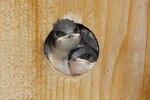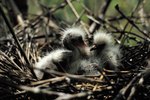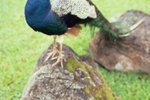
You see a mockingbird nest about 3 to 10 feet off the ground. It's a mockingbird's because you've heard the various songs and seen the trim gray body with flashes of white on the wings. Prowling nearby is a predator. You root for the babies to hurry up and leave the nest as you chase away a cat or squirrel, all the time wondering how much longer you need to play sentry.
From Egg to Flight-Ready
Like most songbirds, mockingbirds incubate eggs for about two weeks before the babies hatch. Songbirds are born altricial, meaning they have no feathers, their eyes are closed and they cannot feed themselves. Precocial birds, like ducks, hatch with feathers, and can stand and eat. Altricial birds need to develop physically and grow wing feathers before flying. Mockingbird chicks rely upon their parents for everything for up to two weeks after hatching.
Fledged and Flying
Ornithologists—scientists who study birds—say a baby bird has fledged when it leaves the nest on its own. Northern mockingbirds—the species found across North America, including Mexico and Canada—leave the nest, or fledge, about 12 days after hatching. According to researchers at the Cornell Lab of Ornithology, fledging means the bird has matured enough to fly, though the ability is "not well developed."
Hanging with Dad
Once the young mockingbirds have fledged, the male mockingbird oversees the further development of the young birds. Fledged birds practice their flight skills and learn to eat under the watchful eye of their father. During this period, people might see birds flapping and fluttering on the ground. Young birds are susceptible to predation, so learning to fly is essential. As the mockingbirds grow in strength and maturity, flying becomes easier.
Independence
After two weeks of learning with their father, the mockingbird young are off on their own. They will have the flying and eating skills needed to survive. At the age of 1 year, both male and female mockingbirds are mature enough to reproduce. Mockingbirds are commonly found in urban environments. Some researchers believe these provide more food and fewer predation problems for mockingbirds than more rural environments. Mockingbirds can live five to eight years in the wild.
References
Photo Credits
-
Stockbyte/Stockbyte/Getty Images




